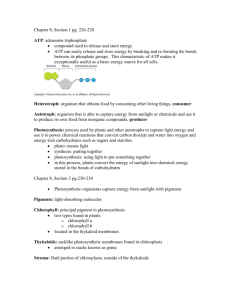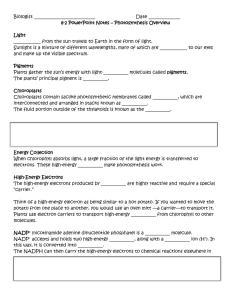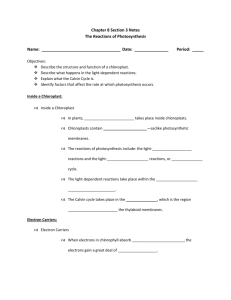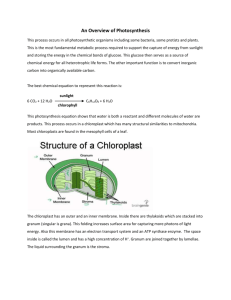Photosynthesis
advertisement
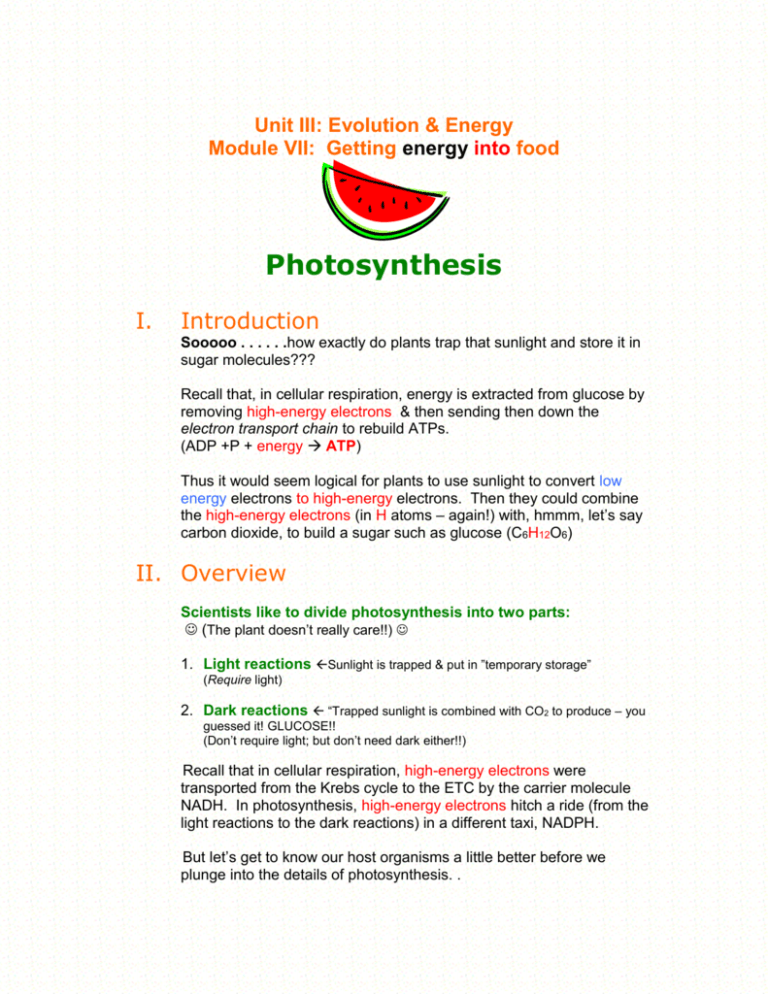
Unit III: Evolution & Energy Module VII: Getting energy into food Photosynthesis I. Introduction Sooooo . . . . . .how exactly do plants trap that sunlight and store it in sugar molecules??? Recall that, in cellular respiration, energy is extracted from glucose by removing high-energy electrons & then sending then down the electron transport chain to rebuild ATPs. (ADP +P + energy ATP) Thus it would seem logical for plants to use sunlight to convert low energy electrons to high-energy electrons. Then they could combine the high-energy electrons (in H atoms – again!) with, hmmm, let’s say carbon dioxide, to build a sugar such as glucose (C6H12O6) II. Overview Scientists like to divide photosynthesis into two parts: (The plant doesn’t really care!!) 1. Light reactions Sunlight is trapped & put in ”temporary storage” (Require light) 2. Dark reactions “Trapped sunlight is combined with CO2 to produce – you guessed it! GLUCOSE!! (Don’t require light; but don’t need dark either!!) Recall that in cellular respiration, high-energy electrons were transported from the Krebs cycle to the ETC by the carrier molecule NADH. In photosynthesis, high-energy electrons hitch a ride (from the light reactions to the dark reactions) in a different taxi, NADPH. But let’s get to know our host organisms a little better before we plunge into the details of photosynthesis. . III. Plant Anatomy In unit IV, (Yea! The end is nearing!) we will study the plant kingdom in detail. Here we will only examine the parts of a higher plant in order to better understand photosynthesis: Photosynthesis occurs in green plants, but where??? Most plants have three non-reproductive organs: roots, stem, and leaves. Click on the plant structure (above) which is the plant’s main organ of photosynthesis. * (Important! Do not skip this step!) * IV. Highlights of Photosynthesis You may recall from your physics course that electrons can sometimes absorb photons of light and “jump” to a higher energy level: http://www.lightlink.com/sergey/java/java/atomphoton/index.html As you just observed, the photon is usually re-emitted after a short time and the electron returns to its ground state. However, if an electron acceptor is nearby, the excited electron can be transferred to this new molecule. Then the energy of the photon remains with the excited electron. I. Light reactions: Occur on membrane surface of Thylakoid disk in chloroplast Trap radiant energy (light) and temporarily store in molecules of NADPH & ATP In the light reactions . . .. 1) chlorophyll and its accessory pigments act as solar collectors and absorb photons of sunlight 2) The photons excite (energize) electrons of chlorophyll. 3) An electron acceptor NADP steals the excited electrons; now it becomes NADPH: NADP + excited electron NADPH 4) NADPH is the “taxi cab” which carried the excited electron (H atom) to the dark reaction in the stroma to make some GLUCOSE!! (Remember, you already learned that the energy of glucose was stored in the high energy electrons associated with its H atoms!!) Now let’s watch a cartoon of the light reactions!! (OH BOY!) Illustration: http://www.biology.com/learning/photo/concepII.html (Be sure to wait for the flash of light to start the process; it takes a few seconds!) 5) Some of the trapped sunlight also stored in molecules of ATP 6) Both the ATP and NADPH molecules will carry the trapped sunlight to the Dark Reactions . . .. BUT WAIT!!!!! II. Dark Reactions (Calvin Cycle)


